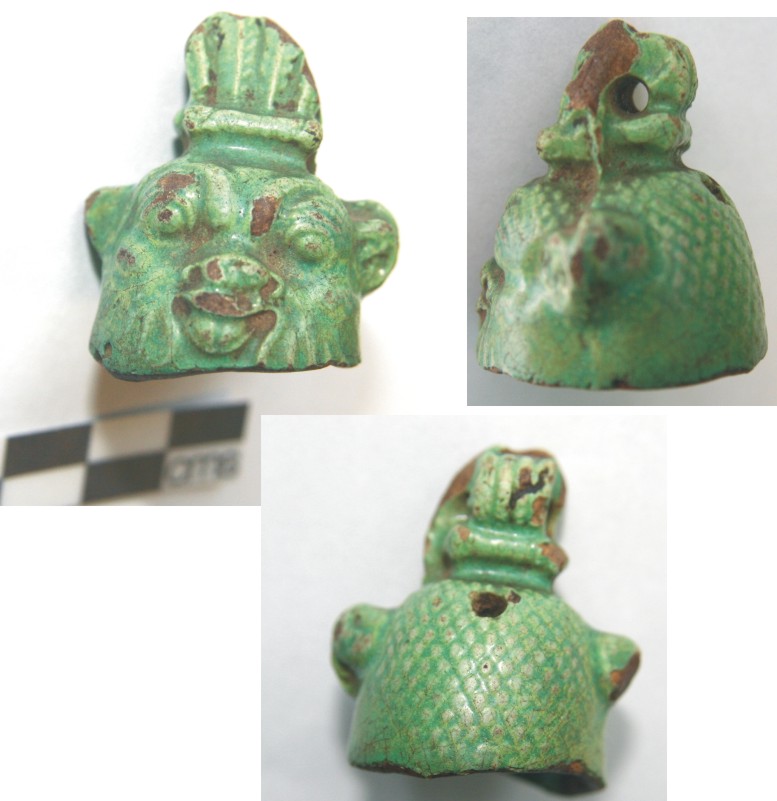WK44
WK44 Faience votive or amuletic bell
 This bell has recently come to us as part of a loan from Woking College. It is made out of pale green faience, is in the shape of a hollow hemispherical Bes head crowned with feathers and has a hole for suspension as well as another, presumably for the tongue of the bell. The tongue itself is missing. One method of attaching the tongue of the bell in ancient Egypt was by means of a split-pin pushed through the hole at the top of the bell, below the handle (Anderson 1976, 29).
This bell has recently come to us as part of a loan from Woking College. It is made out of pale green faience, is in the shape of a hollow hemispherical Bes head crowned with feathers and has a hole for suspension as well as another, presumably for the tongue of the bell. The tongue itself is missing. One method of attaching the tongue of the bell in ancient Egypt was by means of a split-pin pushed through the hole at the top of the bell, below the handle (Anderson 1976, 29).
The list accompanying the objects said that this particular item dates to the 22nd Dynasty (945-715BC), though this could be incorrect. It may have been a little later. Light green faience like this, is usually dated to the Late and Ptolemaic Periods (747-30BC). The fact that this is made from faience suggests it is a votive or amuletic item. Faience would have been fragile if shaken vigorously.
The most convincing parallel we have seen published is an example in the British Museum of a faience bell in the shape of the head of Bes with a feather headdress (EA1963,1112.25; Anderson 1976, 38, 47, fig. 66). There is however, another faience pale green bell in the shape of a Bes head in the Carnarvon-Carter collection at Highclere Castle (H9).
Bronze bells are the most common type of bell in ancient Egypt, and Bes headed bronze examples are also known (e.g. BM EA1847,0806.161; Anderson 1976, 32, 33, fig.48 and Cairo Museum JE53326). The Petrie Museum also has several bronze bells similar to ours (UC52168, UC52169, UC33266, UC8976). Petrie dates them from the 26th Dynasty to the Roman Period (Petrie 1914, 28, fig. 124; see also Petrie 1927, 58, pl. L nos 299 and 300). The Petrie museum also has faience bells without Bes heads dated to the Roman Period (UC59163). Plain bronze bells, including miniature examples, are known from the Fayum and Karanis dating to 2nd-4th Centuries AD (see also examples in Anderson 1976).
The deity Bes is usually associated with percussion instruments, usually the hand drum/tambourine, and occasionally a harp.
Interestingly, Petrie (1914, 58) suggested that Bes bells were amuletic and perhaps worn around the necks of children to protect them. Bes was a protective deity, particularly for women in childbirth and for young children. Additionally, the protective nature of these bells is reinforced by the British Museum and Cairo Museum examples (BM EA1963,1112.25 and JE53326 respectively) which has not only Bes, but also other animals such as lizards (as though to protect against such dangerous things). Bells, in several cultures, are used to ward off evil.
Unfortunately, we know of no provenanced examples for Bes-headed bells, so whether they were domestic charms or perhaps votive offerings placed in temples, I do not know. However, plain bronze bells have been found in burials (Gadalla 2007, 218). At Late and Ptolemaic Matmar, 2 bronze bells were found in burials (Brunton 1948, 76 and 91). One was found in the grave of a child (Brunton 1948, 91) and the other was found on a chain around the neck of a woman (Brunton 1948, 76). A possible third bell, much corroded, was found on the chest of the woman. Petrie describes plain bronze bells, mainly in children’s burials (Petrie 1906, 39, 40, 41, 42, 45), the earliest appear to date to the 23rd Dynasty (Petrie 1906, 17, 18, pl. XIXA).
Finally, it is possible that bell Bes heads are related to Bes head amulets. Amulets in the shape of Bes’s head alone, as opposed to his whole body, are known from the Third Intermediate Period onward (c.1000BC onward).
We would be glad to hear of further examples.
Anderson, R.D. 1976 Catalogue of Egyptian Antiquities in the British Museum III, Musical Instruments. London.
Brunton, G. 1948. Matmar. London.
Gadalla, M. 2007. The Ancient Egyptian Culture Revealed. Greensboro.
Petrie, W.M.F. 1906. Hyksos and Israelite Cities. London.
Petrie, W.M.F. 1914. Amulets. London.
Petrie, W.M.F. 1927. Objects of Daily Use. London.
Other items associated with music in the Egypt Centre